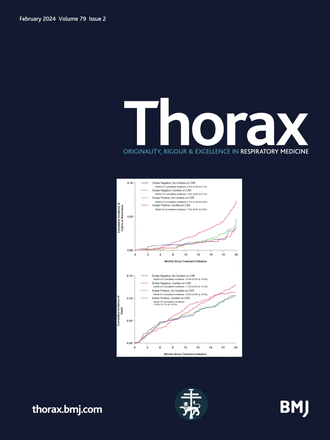IF 9
1区 医学
Q1 RESPIRATORY SYSTEM
引用次数: 0
摘要
目标 哮喘和 2 型糖尿病是全球发病率的两个重要原因。我们研究了瑞典成年人中 2 型糖尿病与哮喘的相关性以及这两种疾病的家族聚集性。方法 我们在 2009 年至 2013 年期间对瑞典所有 25-85 岁的成年人进行了横断面研究。哮喘和 2 型糖尿病状况通过健康登记册确定。模型根据性别、年龄、教育水平、收入和出生国家进行了调整,在一个子集中还根据体重指数(BMI)进行了调整。我们还进一步进行了家族共聚分析,以确定共同的家族因素是否可以解释观察到的结果。结果 该研究包括 5 299 245 名参与者,其中 25 292 人(0.5%)同时患有哮喘和 2 型糖尿病。在总人口中,2型糖尿病与哮喘之间的相关系数为1.47(95% CI为1.45至1.49);在男性人口中为1.30(95% CI为1.27至1.32),在女性人口中为1.63(95% CI为1.60至1.66)。男性(1.51 (95% CI 1.45 to 1.56))和女性(2.04 (95% CI 1.96 to 2.11))的OR值略高于有BMI测量值的人群,但在对BMI进行调整后,OR值有所降低(1.45 (95% CI 1.40 to 1.51))和(1.76 (95% CI 1.68 to 1.84))。与不患有哮喘的兄弟姐妹相比,患有哮喘的兄弟姐妹更有可能患糖尿病(1.13 (95% CI 1.10 to 1.15))。结论 我们发现,哮喘与 2 型糖尿病之间的关系在调整体重指数后仍然存在,这表明仅靠体重指数并不能解释这种关系。我们还发现,这两种疾病会在兄弟姐妹中共同聚集,这表明这种关联部分是由于共同的家族遗传和环境风险因素造成的。如有合理要求,可提供数据。原始数据由瑞典国家卫生与福利委员会和瑞典统计局保存。根据瑞典数据存储法,我们不能公开数据。不过,任何研究人员都可以通过获得瑞典伦理审查机构的伦理批准来获取数据,然后向登记处索要原始数据。如果能与卡罗林斯卡医学院(Karolinska Institutet)达成适当的数据共享协议,本研究的主要研究人员也可应要求提供化名数据。本文章由计算机程序翻译,如有差异,请以英文原文为准。
Association between asthma and type 2 diabetes in a Swedish adult population: a register-based cross-sectional study
Objective Asthma and type 2 diabetes are two important causes of morbidity globally. We examined both the association of type 2 diabetes with asthma in Swedish adults and the familial co-aggregation of the diseases. Methods We conducted a cross-sectional study of all adults aged 25–85 in Sweden between 2009 and 2013. Asthma and type 2 diabetes status were ascertained from the health registers. Models were adjusted for sex, age, education level, income and country of birth and in a subset, for body mass index (BMI). We further conducted a familial coaggregation analysis to determine if shared familial factors could explain any observed findings. Results The study included 5 299 245 participants, 25 292 (0.5%) had both asthma and type 2 diabetes. In the total population, the OR for the association between type 2 diabetes and asthma was 1.47 (95% CI 1.45 to 1.49); in the population of men (1.30 (95% CI 1.27 to 1.32)) and women (1.63 (95% CI 1.60 to 1.66)). The ORs were slightly higher among men (1.51 (95% CI 1.45 to 1.56)) and women (2.04 (95% CI 1.96 to 2.11)) for whom BMI measurements were available but attenuated with adjustment for BMI (1.45 (95% CI 1.40 to 1.51)) and (1.76 (95% CI 1.68 to 1.84)). Diabetes was more likely if a full sibling had asthma than if the sibling did not (1.13 (95% CI 1.10 to 1.15)). Conclusions We found an association between asthma and type 2 diabetes that was sustained after adjusting for BMI, indicating that BMI alone does not explain this relationship. We also found that the two conditions coaggregate in siblings, indicating that the association is partly due to shared familial genetic and environmental risk factors. Data are available on reasonable request. Original data are held by Swedish National Board of Health and Welfare and Statistics Sweden. Due to Swedish data storage laws, we cannot make the data publicly available. However, any researcher can access the data by obtaining an ethical approval from the Swedish Ethical Review Authority and thereafter asking the registers for the original data. Pseudonymised data can also be provided from the principal investigator of this study on request after providing a reasonable proposal and if an appropriate data sharing agreement with Karolinska Institutet can be established.
求助全文
通过发布文献求助,成功后即可免费获取论文全文。
去求助
来源期刊

Thorax
医学-呼吸系统
CiteScore
16.10
自引率
2.00%
发文量
197
审稿时长
1 months
期刊介绍:
Thorax stands as one of the premier respiratory medicine journals globally, featuring clinical and experimental research articles spanning respiratory medicine, pediatrics, immunology, pharmacology, pathology, and surgery. The journal's mission is to publish noteworthy advancements in scientific understanding that are poised to influence clinical practice significantly. This encompasses articles delving into basic and translational mechanisms applicable to clinical material, covering areas such as cell and molecular biology, genetics, epidemiology, and immunology.
 求助内容:
求助内容: 应助结果提醒方式:
应助结果提醒方式:


